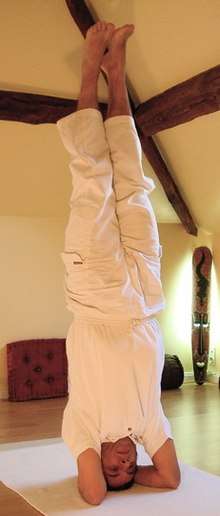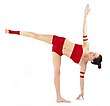Shirshasana
Salamba Shirshasana, often shortened to Shirshasana, or Yoga Headstand is an inverted asana in modern yoga as exercise; it was described as both an asana and a mudra in classical hatha yoga, under different names.
Etymology and origins
_from_Jogapradipika_1830.jpg)
The name Salamba Shirshasana comes from the Sanskrit words सालम्ब Sālamba meaning "supported", शीर्ष, Śīrṣa meaning "head",[2] and आसन, Āsana meaning "posture" or "seat".[3]
The name Śīrṣāsana is relatively recent; the pose itself is much older, but was known by other names. Like other inversions, it was practised as Viparita Karani, described as a mudra in the Hatha Yoga Pradipika and other classical texts on haṭha yoga.[4] Hemacandra's 11th century Yogaśāstra names it Duryodhanāsana ("Duryodhana's pose") or Kapālīkarana ("head technique"),[5] while the 18th century Joga Pradīpikā calls it Kapālī āsana, head posture; it is number 17 of the set of 84 asanas described and illustrated there.[1] However, the 19th century Sritattvanidhi uses the name Śīrṣāsana as well as Kapālāsana.[6] The Malla Purana, a 13th century manual for wrestlers, names but does not describe 18 asanas including Śīrṣāsana.[6]
Description
In the Supported Headstand (Salamba Śīrṣāsana), the body is completely inverted, and held upright supported by the forearms and the crown of the head.[7] In his Light on Yoga, B. K. S. Iyengar uses a forearm support, with the fingers interlocked around the head, for the basic posture Śīrṣāsana I and its variations; he demonstrates a Western-style tripod headstand, the palms of the hands on the ground with raised elbows, for Śīrṣāsana II and III; and other supports for further variants. Iyengar names and illustrates ten variants in all, as well as several preparatory and transitional poses.[8]
The yoga headstand is nicknamed "king" of all the asanas.[9][10][11][12][13] A variety of other asanas can be used to build the upper body strength and balance required for Sirsasana.[14]
Cautions
The pose is advised against in case of high blood pressure,[14][15] heart palpitations, glaucoma,[15] during menstruation,[14] or hiatal hernia.[14]
Sirsasana, alongside Sarvangasana and Padmasana, is one of the asanas most often reported as the cause of an injury.[16][17]
Variations
.jpg)
Shirshasana permits many variations, including:
| Transliteration | English | Image |
|---|---|---|
| Salamba Shirshasana 2 | Headstand 2 (palms down, shoulder width) | |
| Salamba Shirshasana 3 | Headstand 3 (palms down, in front of face) | |
| Baddha Hasta Shirshasana | Bound Hands Headstand | |
| Baddha Konasana Shirshasana | Bound Angle Pose in Headstand | |
| Dvi Pada Viparita Dandasana[18] | Headstand Backbend | |
| Eka Pada Shirshasana[lower-alpha 1] | Single Leg Headstand | |
| Mukta Hasta Shirshasana | Free Hands Headstand | |
| Parivrttaikapada Shirshasana | Single Leg Revolved Headstand | |
| Parshva Shirshasana | Side Headstand | |
| Parshvaikapada Shirshasana | Single Leg Headstand | |
| Upavistha Konasana Shirshasana | Seated Angle Pose in Headstand | |
| Urdhva Padmasana in Shirshasana | Upward Lotus in Headstand |
Mandalasana, Circle pose, is not a single variation but a sequence of movements in Shirshasana in which the legs move in a full circle around the body from one headstand variation to the next.[19][20]
See also
Notes
- This name is used in Light on Yoga for two unrelated asanas, namely this variant of headstand, and for a leg-behind-head sitting pose close to Akarna Dhanurasana, shooting bow pose.
References
- Bühnemann, Gudrun (2007). Eighty-Four Asanas in Yoga: A Survey of Traditions. New Delhi: D. K. Printworld. pp. 47, 151. ISBN 978-8124604175.
- "Shirshasana A - AshtangaYoga.info". Retrieved 11 April 2011.
- Sinha, S. C. (1 June 1996). Dictionary of Philosophy. Anmol Publications. p. 18. ISBN 978-81-7041-293-9.
- Hatha Yoga Pradipika III.7
- Mallinson, James; Singleton, Mark (2017). Roots of Yoga. Penguin Books. p. 104. ISBN 978-0-241-25304-5. OCLC 928480104.
- Sjoman, Norman E. (1999) [1996]. The Yoga Tradition of the Mysore Palace (2nd ed.). Abhinav Publications. pp. 56–57, plate 6 (asana 31) and note 89, page 67. ISBN 81-7017-389-2.
- "Supported Headstand". Yoga Journal. Retrieved 11 April 2011.
- Iyengar, B. K. S. (1979) [1966]. Light on Yoga: Yoga Dipika. Unwin Paperbacks. pp. 179–203.
- Iyengar, B. K. S. (1970). Light on yoga: yoga dīpikā. Schocken Books. p. 127.
... Sirsasana the king of all asanas and the reasons are not hard to find.
- Iyengar, Geeta (1 June 1998). Yoga: A Gem for Women. Allied Publishers. p. 187. ISBN 978-81-7023-715-0.
- Hoare, Sophy (1977). Yoga. Macdonald Educational. p. 78. ISBN 978-0-356-06012-5.
- Ramdev, Swami (1 March 2006). Yoga: Its Philosophy & Practice. Diamond Pocket Books. p. 92. ISBN 978-81-89235-15-4.
- Norberg, Ulrica; Lundberg, Andreas (8 April 2008). Hatha Yoga: The Body's Path to Balance, Focus, and Strength. Skyhorse Publishing. p. 105. ISBN 978-1-60239-218-2.
Sirsasana is called the king of the asanas because it helps to open Sahasrara chakra, the crown chakra, and it stabilizes the pituitary gland.
- Schumacher, John (July–August 1990). "Preparing for Inversions". Yoga Journal (93): 68–77.
- Summers, Kathleen. "Sirsasana: Can You Bleed From the Headstand?". TheYogaDr.com. Retrieved 21 November 2012.
- Acott, Ted S.; Cramer, Holger; Krucoff, Carol; Dobos, Gustav (2013). "Adverse Events Associated with Yoga: A Systematic Review of Published Case Reports and Case Series". PLoS ONE. 8 (10): e75515. doi:10.1371/journal.pone.0075515. ISSN 1932-6203.
- Penman, Stephen; Stevens, Philip; Cohen, Marc; Jackson, Sue (2012). "Yoga in Australia: Results of a national survey". International Journal of Yoga. 5 (2): 92. doi:10.4103/0973-6131.98217. ISSN 0973-6131.
- Iyengar, B. K. S. (1970). Light on yoga: yoga dīpikā. Schocken Books. pp. 373–377.
- "Circle Pose (Mandalasana): Steps, Precautions And Health Benefits". Retrieved 26 June 2016.
- "Peak Pose: Mandalasana (Headstand Variation)". Retrieved 26 June 2016.
Further reading
- Iyengar, B. K. S. (1 October 2005). Illustrated Light On Yoga. HarperCollins. ISBN 978-81-7223-606-9. Retrieved 9 April 2011.
- Saraswati, Swami Satyananda (1 August 2003). Asana Pranayama Mudra Bandha. Nesma Books India. ISBN 978-81-86336-14-4. Retrieved 9 April 2011.
- Saraswati, Swami Satyananda (January 2004). A Systematic Course in the Ancient Tantric Techniques of Yoga and Kriya. Nesma Books India. ISBN 978-81-85787-08-4. Retrieved 9 April 2011.


_from_Jogapradipika_1830_(detail).jpg)

